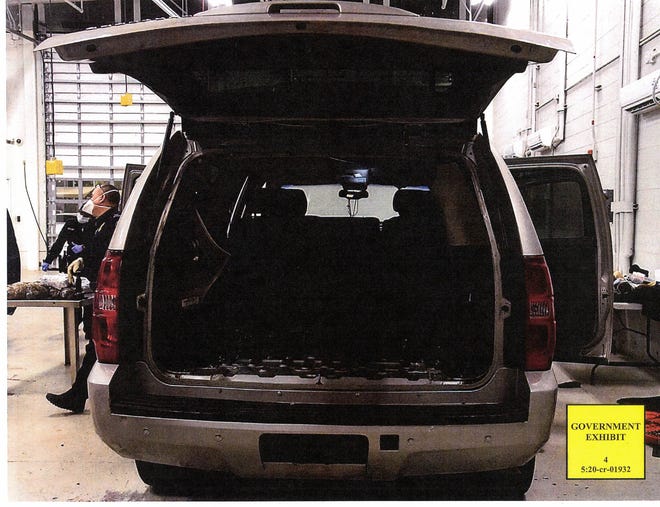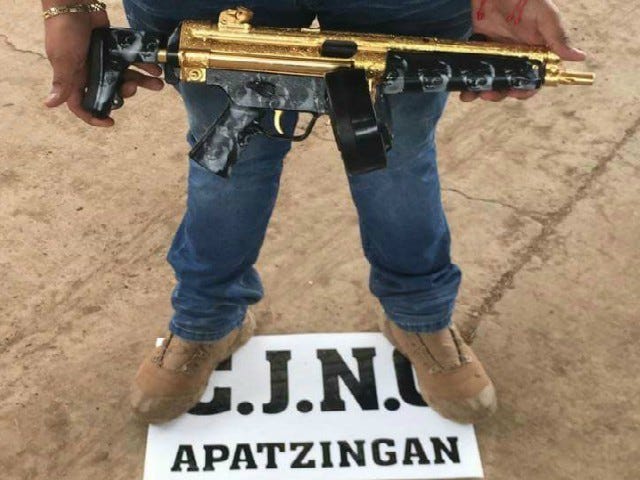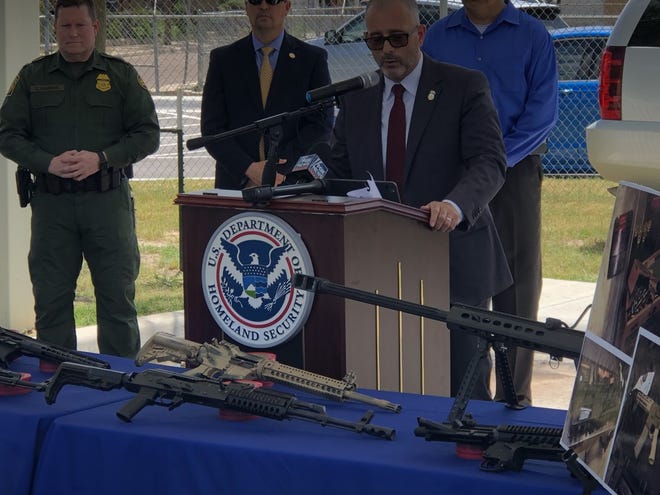[ad_1]
A Washington man drove to a U.S. border crossing last year in his teal Ford pickup truck loaded with a hidden arsenal bound for a Mexican cartel war zone.
Miguel Diaz Calderon never made it out of Texas. U.S. Customs agents searched his vehicle at the Eagle Pass crossing and found 43 shotguns, rifles and pistols. They also discovered more than 10,000 rounds of ammunition hidden in an ice chest in the gas tank and inside the spare tire, court records show.
Diaz is part of what cartel members call the “Hormiga,” Spanish for “ant,” referring to an ant trail of reliably flowing weapons transported from the southern U.S. to Mexico, said Jaeson Jones, who tracks cartel trends and previously managed the daily operations of the Texas Rangers’ Border Security Operations Center.
The Mexican government estimates that more than half a million guns are smuggled from the U.S. each year, arming Mexico’s deadly cartel wars. Officials in Mexico — which has just one gun store and issues fewer than 50 gun permits a year — blame lax U.S. gun laws and the prevalence of gun shops in America for the bulk of weapons that allow cartels to flourish. Earlier this month, the Mexican government sued U.S. gun manufacturers in federal court, accusing them of fueling the violence.
Diaz is one of 360 suspects arrested so far during Operation Without a Trace, an ongoing crackdown launched nearly two years ago by Homeland Security Investigations and U.S. Customs and Border Protection to intercept illegal guns, said Joseph Lestrange, division chief of Homeland Security’s Transnational Organized Crime.
These agencies team with the U.S. Bureau of Alcohol, Tobacco, Firearms and Explosives to investigate the financing, transportation, and communications methods of smuggling networks.
Agents launched 534 investigations, seized $29 million and intercepted more than 1,200 guns, 4,700 magazines for semi-automatic and automatic weapons and 700,000 rounds of ammunition headed to Mexico, Lestrange told The Courier Journal this month.
Cartels:As Mexican drug groups cut in on avocado sales by extorting growers, armed locals fight back

“The majority of weapons we’ve seized since we started this operation have been in the corridor by Laredo, Texas — from Laredo to El Paso,” he said.
Diaz, who lived in Union Gap, a three-hour drive from Seattle, tried to cross the border northwest of Laredo on International Bridge 2 on May 5, 2020. The bridge connects Eagle Pass, Texas, to the Northern Mexico city of Piedras Negras in the state of Coahuila.
After his arrest, Diaz told agents with Homeland Security Investigations he was paid $5,000 upfront to smuggle “fierros,” Spanish for “iron,” which he understood to be guns, across the border.
He expected to be paid an additional $5,000 once the guns were delivered to Michoacán, Mexico, according to court records. He claimed he didn’t know the names of the gun buyers or their cartel affiliations.
In Michoacán, the global powerhouse Cártel Jalisco Nueva Generación, or CJNG, has been engaged in a long and deadly battle with Sinaloa and other rival cartels.
“It’s hard to pinpoint exactly where we think a particular load (of guns) we seized was going,” Lestrange said. Some suspects won’t talk after their arrests and others admit smuggling guns but claim they don’t know the names of the buyers or the cartel involved.
“But we also know most of the violence the Mexican government is concerned about against police and against institutions is coming from CJNG and the Sinaloa Cartel” run by the notorious kingpin “El Chapo,” Lestrange said.

El Mencho:Daughter of Mexican cartel boss sentenced to US prison for violation of Kingpin Act
If Diaz had sneaked his arsenal past U.S. Customs officials, he would have had to pay a “piso,” or fee, to members of the Cártel del Noreste, or CDN, which dominates this area of northern Mexico, Jones said.
Even though CDN is a rival of CJNG, its members accept payments to allow drugs or guns to pass through their territory.
After paying the piso and traveling through Coahuila, Diaz still would have faced a 14-hour drive south to Michoacán.
The state, about a five-hour drive west of Mexico City, is known for its production of avocados. It is also the native land of ruthless Mexican cartel boss Rubén Oseguera Cervantes, a top U.S. target with a $10 million reward for information on his whereabouts.
Known as “El Mencho,” he commands the 5,000 member CJNG, now as powerful as the Sinaloa Cartel but less known.
A special investigative report in 2019 by The Courier Journal warned of CJNG’s ruthlessness in Mexico and its reach across the U.S. into small towns. CJNG is based in Guadalajara, Mexico’s second-largest city, in the state of Jalisco. But it has expanded operations in the majority of Mexico’s states.
The U.S. Drug Enforcement Administration blames CJNG and the Sinaloa Cartel for the bulk of America’s illicit fentanyl, the top killer during the deadliest drug epidemic in U.S. history.

Meanwhile, the Mexican government blames prominent U.S. gun manufacturers for the influx of cartel weapons in its lawsuit against them in federal court in Boston.
“Almost all guns recovered at crime scenes in Mexico — 70% to 90% of them — were trafficked from the U.S.,” the Mexican government claims in its complaint.
An estimated 20 attorneys, many based in Texas, are expected to unite to represent Mexico, including six companies they blame for the bulk of recovered crime guns there: Smith & Wesson, Beretta, Century Arms, Colt, Glock and Ruger.
Officers found all of those brands, except Century Arms, in the shipments smuggled by Diaz, court records show.
The Mexican government claims that more than 68% of illegal guns smuggled across the border are made by those companies, along with Barrett and Witmer Public Safety Group, which acquired Interstate Arms.
“As a result of the continued use and possession of many of these guns, residents of Mexico will continue to be killed and injured by these guns, and the public will continue to fear for their health, safety, and welfare,” American attorneys wrote in the suit on behalf of Mexico.
Mexico suffered more than 40,000 fatal shootings in 2018, according to public briefings by Mexico’s Foreign Minister Marcelo Ebrard. Of the guns used in crimes in Mexico and traced back to the United States, about 41% came from Texas, he said.
An estimated 19% came from California, 15% from Arizona and 25% from other states.
Some of the reasons so many guns come from Texas: people can cross the border on land or by the Rio Grande River, and “in places like Houston and San Antonio, there’s a gun store on every corner,” said Will Glaspy, formerly in charge of DEA’s Houston Division.
Cartels seek out military-grade weapons, he said: “The bigger the better.”
Mexican military forces confiscated 71 armor-piercing 50-caliber guns in the year ending January 2020, according to the Cabinet of the Minister of Foreign Affairs in Mexico.
That included rifles manufactured in Tennessee and Arkansas capable of downing aircraft or ripping through armored police cars and tanks.
CJNG members posted a video that went viral on social media in July 2020 showing off their arsenal of tanks and .50-caliber guns. DEA agents say the cartel was trying to instill fear in its enemies and woo new members.
The majority of U.S. states allow citizens to buy .50-caliber weapons, something Mexico reserves for its military.
Orchestrating straw purchases
Cartels often use drug profits to pay Americans to buy weapons for them at retail stores and gun shows, called straw purchases. The cartels then use their members or contract with associates to serve as “consolidators.”
Those associates arrange the purchase of several guns — keeping them at stash houses or handing them off to transporters in gas station parking lots or other neutral locations, Lestrange said.
A Dallas man claimed he didn’t know assault rifles, pistols and ammunition were hidden in his silver SUV as he attempted to cross into Mexico from Laredo, Texas.
A jury didn’t believe him, convicting Jose Rafael Vasquez last month of attempting to smuggle goods out of the country. U.S. Customs and Border Protection agents contend Vasquez told them he was headed to the city of Matehuala, a seven-hour drive south of Laredo, Texas, in the Mexican state of San Luis Potosí.
There, members of the Gulf Cartel and CJNG have formed a partnership, Jones said.

U.S. Customs and Border Protection officers with an Anti-Terrorism Contraband Enforcement Team were screening traffic headed out of Laredo on the Lincoln-Juarez Bridge in October when they noticed a bundle under the carriage of Vasquez’s SUV, secured with black ties.
Investigators found several guns inside the packages, as well as in a secret compartment in the paneling.
Officers found three rifles, eight pistols, several magazines and more than 4,700 rounds, including a bag of bullets under Vasquez’s seat and more ammunition wrapped in tape and plastic and tucked inside a hidden compartment between the exterior and interior paneling.
Diaz, who pleaded guilty, and Vasquez are awaiting sentencing. They could each face up to 10 years in prison.
Diaz’s attorney, Gregory Torres, declined comment. Vasquez’s attorney, Silverio Martinez, said he plans to lobby for leniency, even probation, arguing this is his client’s first arrest.
Vasquez was born in Mexico but raised his family in Dallas, where he ran a moving company with his three adult sons. He sometimes loaned his SUV to his employees and his relatives and argues that one of them could have hidden the guns, Martinez said.
“He never saw those guns,” his attorney told The Courier Journal.
To intercept more Mexico-bound guns, the U.S. Southwest Border Counternarcotics Strategy of 2020, of the National Drug Control Policy, vowed that “the United States will improve criminal-intelligence and information-sharing for illegal weapons trafficking and enhance cooperation with international partners.”
Operation Without a Trace works in sync with efforts by ATF, which targets straw purchasers, and the DEA, whose agents piece together conspiracy cases by identifying drug networks and their links to specific cartels.
Homeland Security teamed with the ATF to launch a confidential tip line asking for help from the public, displaying the number on about 200 billboards near the border, asking for information on illegal guns bound for Mexico.
U.S. agents also are helping train Mexican police on investigative techniques and evidence collection and improving intelligence sharing, Lestrange said.
“We’ve got agents and we’ve got trained criminal investigators from the host government in Mexico working investigations in Mexico,” he said. “And they’re sending leads up to us to connect the dots.”
Reporter Karol Suárez contributed to this story.
Follow reporter Beth Warren on Twitter: @BethWarrenCJ
[ad_2]
Source link





/cloudfront-us-east-2.images.arcpublishing.com/reuters/523RGTOG4VNWBIJZR76H4QTKVI.jpg)
/cloudfront-us-east-2.images.arcpublishing.com/reuters/OCUD6SRRWZIEVGPT73GKHJAK44.jpg)






